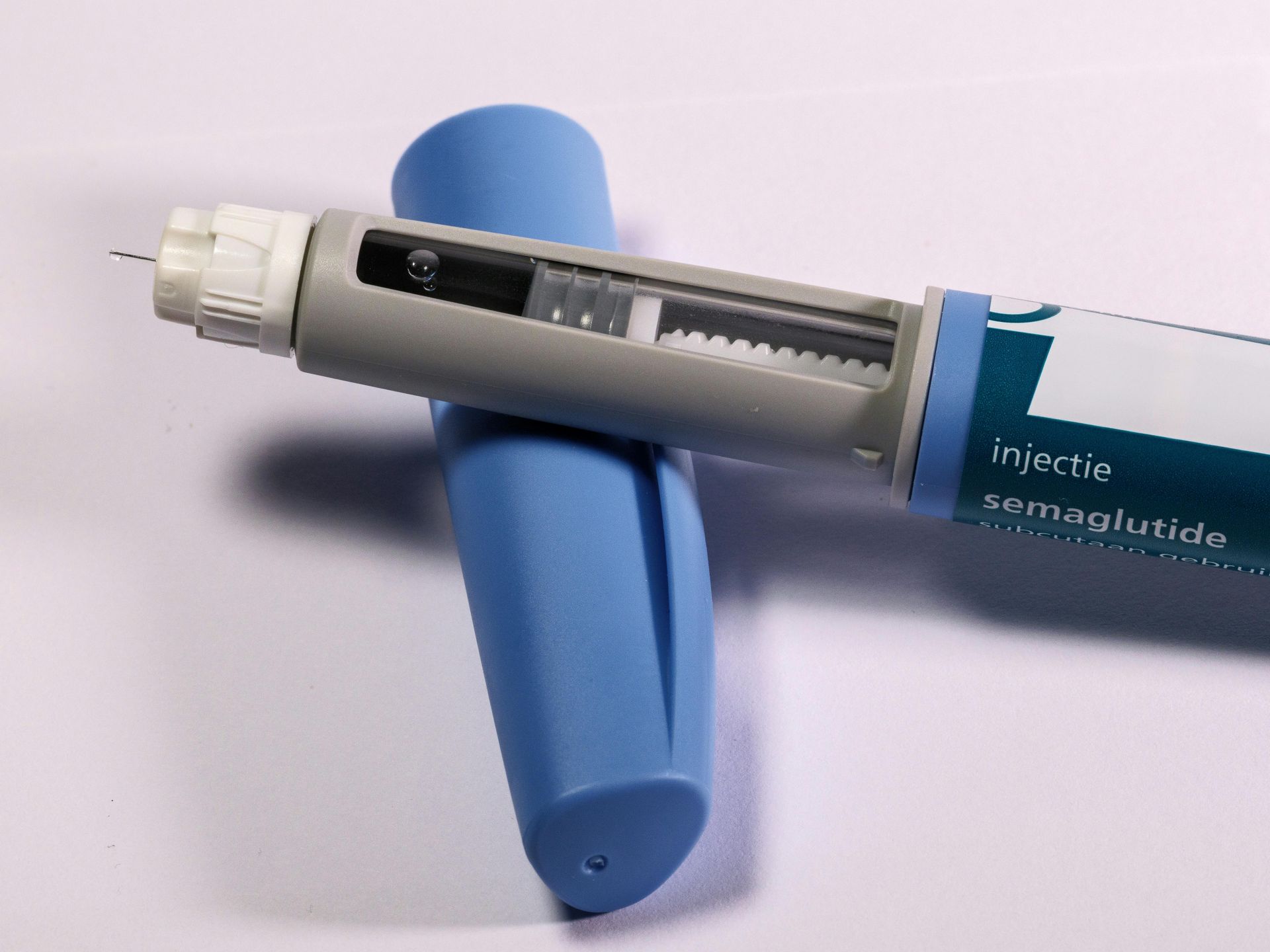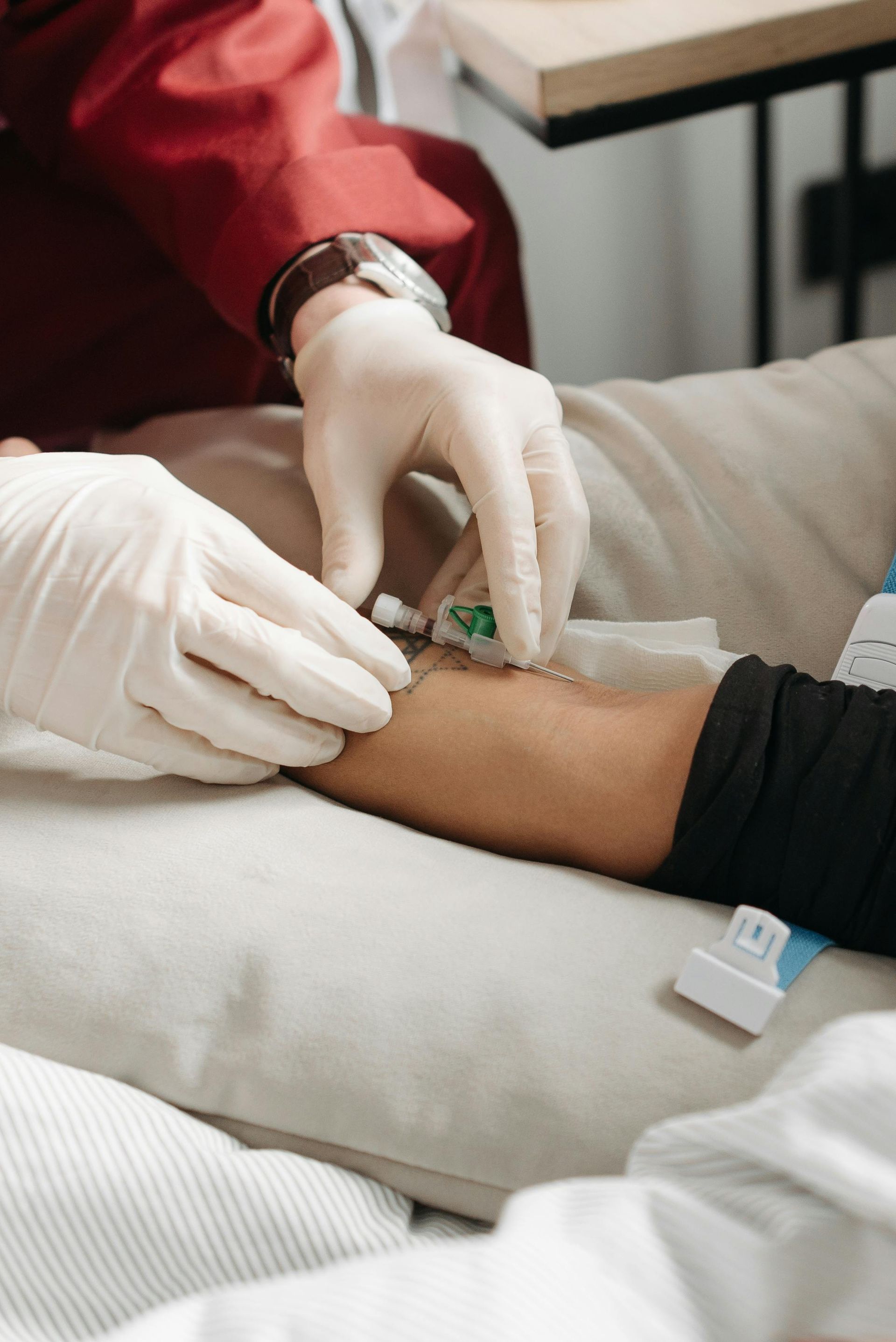IV Fluids for Infection: Fast Relief and Hydration at Home
Understanding IV Fluids and Their Administration
When your body is fighting off an illness, it's common to feel drained and unwell. This is where IV fluids for infection can play a crucial supportive role. If you're wondering how IV fluids help when you're battling an infection, here's the quick answer:
IV fluids can significantly aid your recovery from infection by:
- Rapidly rehydrating your body: Infections often cause fluid loss through fever, vomiting, or diarrhea, leading to dehydration. IV fluids bypass the digestive system for fast absorption.
- Restoring electrolyte balance: Illness can deplete essential minerals like sodium, potassium, and chloride. IV fluids with electrolytes help bring these back into balance.
- Supporting vital organ function: Adequate hydration maintains blood pressure and ensures your organs receive the blood flow they need to function properly, especially critical during severe infections.
- Creating an optimal environment for healing: By addressing dehydration and nutrient imbalances, IV fluids help your immune system work more efficiently to fight off the infection.
Infections can hit hard, leaving you feeling weak and depleted. Whether it's a stomach bug causing severe dehydration or a more serious condition, your body needs all the support it can get to recover. IV fluids deliver essential hydration and nutrients directly into your bloodstream, providing rapid relief and helping your body's natural defenses work their best.
I'm Gabriel Abrams, founder of Elite Mobile IV. With my background in nursing, I've seen how crucial proper hydration and nutrient support are in aiding recovery, especially when it comes to supporting the body's fight against infection. At Elite Mobile IV, we bring professional, hospital-grade IV fluids for infection support and wellness treatments directly to you.
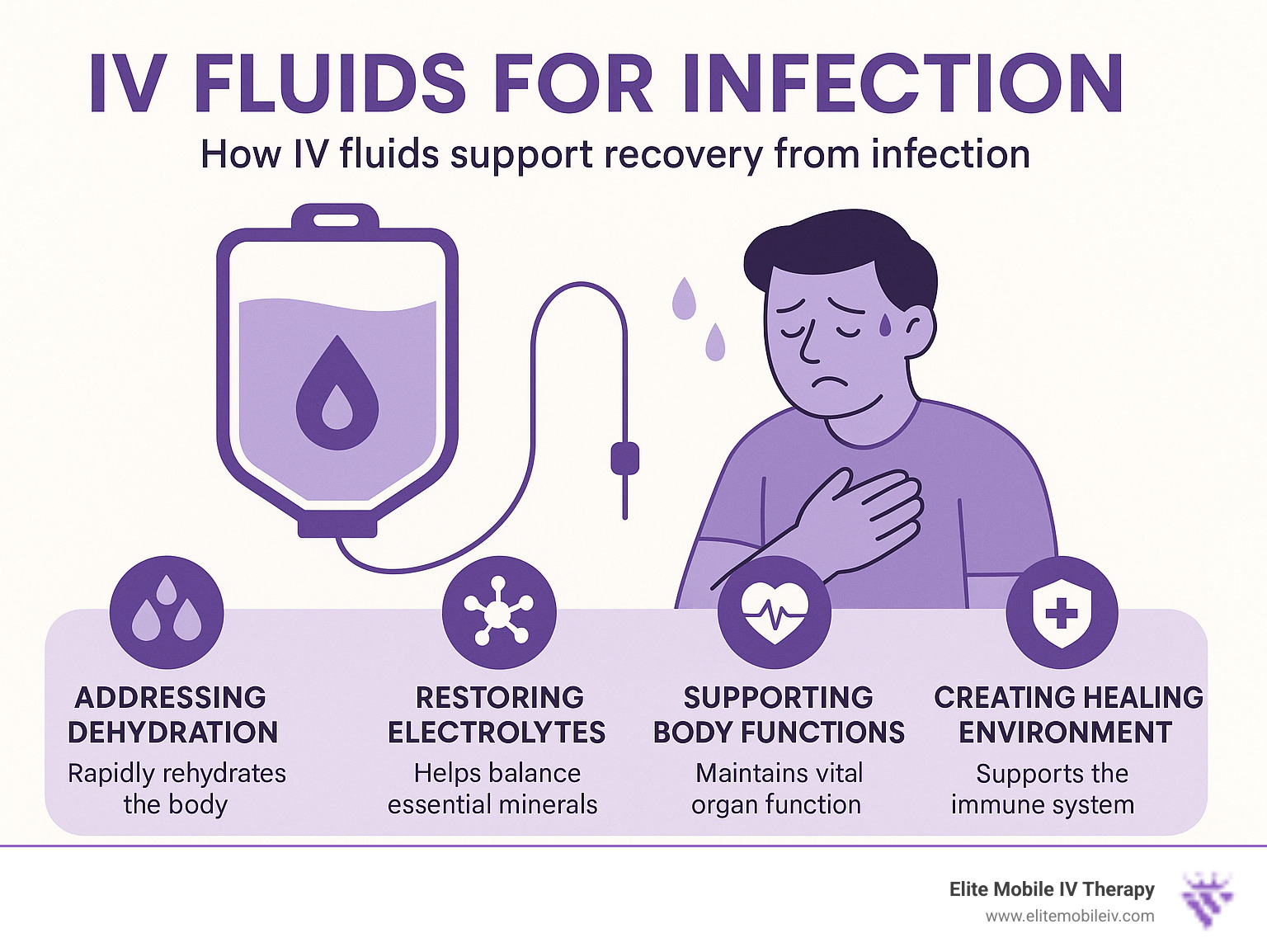
When we talk about IV fluids for infection, it's important to first understand what these fluids are and how they are administered. Intravenous (IV) therapy is a medical procedure where fluids, medications, or nutrients are delivered directly into a patient's vein. This method ensures rapid absorption and immediate availability to the body, making it incredibly effective when time is of the essence, such as during an active infection.
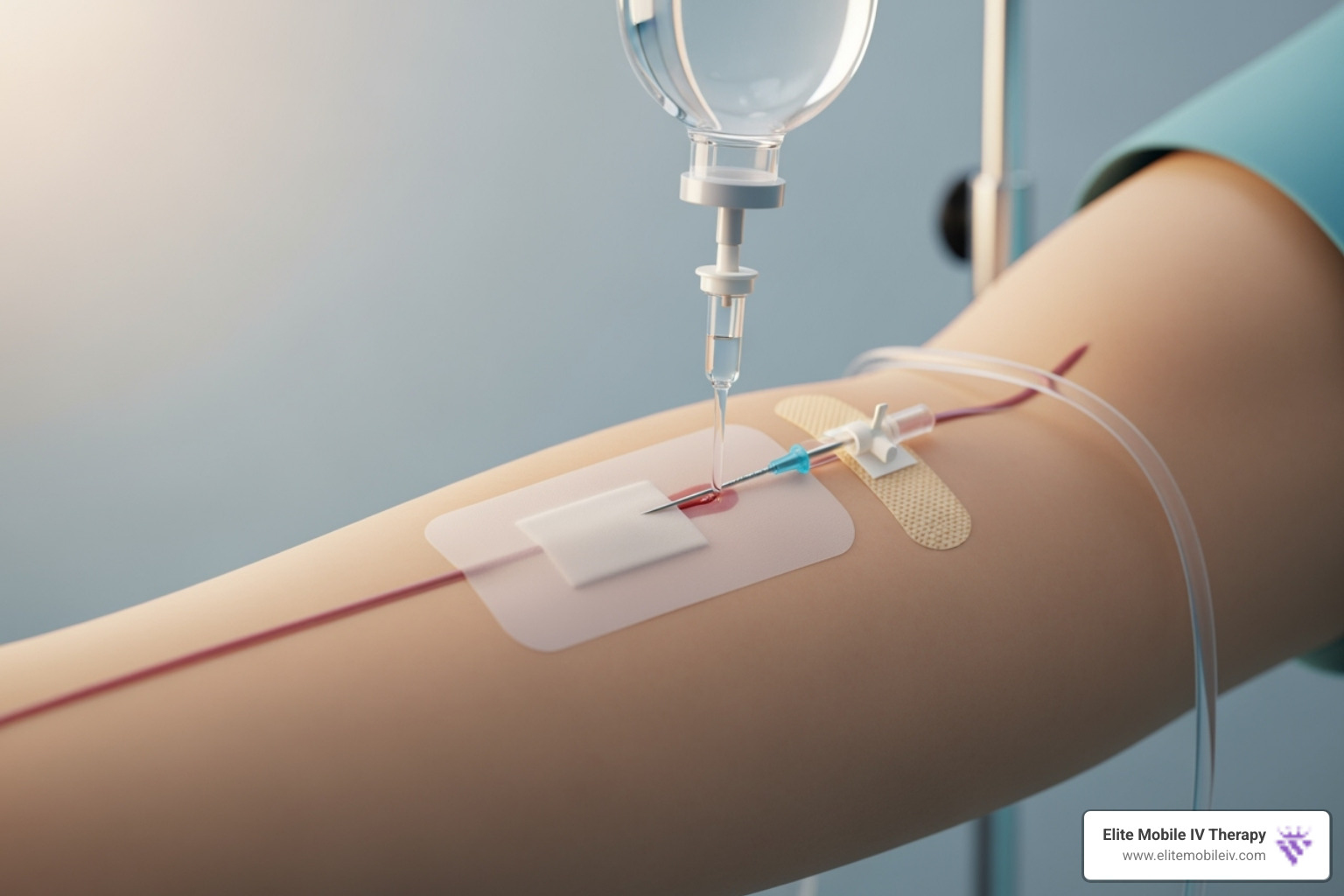
What Are IV Fluids?
At their core, IV fluids are sterile solutions designed to replenish lost fluids, restore electrolyte balance, and sometimes provide essential nutrients. They generally fall into two main categories:
- Crystalloids: These are the most common type of IV fluids. They contain small molecules that can easily pass from the bloodstream into the body's tissues. Examples include:
- Saline solution (0.9% Sodium Chloride): This is a basic salt water solution, isotonic with our body's fluids, meaning it has a similar concentration of solutes. It's widely used for rehydration and to maintain fluid balance.
- Lactated Ringer's solution (LR): This solution contains sodium, chloride, potassium, calcium, and lactate. It's often preferred because its electrolyte composition is closer to that of human blood plasma, making it a "balanced salt solution." Scientific research, such as that supported by the CDC for rehydration therapy, highlights the effectiveness of solutions like Ringer's lactate in conditions like cholera, where significant fluid and electrolyte loss occurs. You can find more information on rehydration therapy using solutions like Ringer's lactate here: Scientific research on Ringer's lactate solution.
- Dextrose solutions: These contain sugar (glucose) and are used to provide calories and free water, which can help prevent dehydration and ketosis. They are often combined with saline.
- Colloids: These fluids contain larger molecules, such as proteins (like albumin), that tend to stay within the bloodstream for longer periods, helping to pull fluid back into the vessels. They are used in specific situations, often when a patient needs to maintain blood volume without adding too much overall fluid.
The choice of fluid depends entirely on a patient's specific needs, the type of infection, and their underlying health conditions. Our medical professionals carefully assess each client to determine the most appropriate fluid for their unique situation.
How Are IV Fluids Given?
The administration of IV fluids is a precise medical procedure that must be performed by a trained healthcare professional. Here's a general overview of how we administer IV fluids:
- Preparation: We begin by gathering all necessary sterile equipment, including the IV fluid bag, an IV line (tubing), an IV catheter (a small, flexible tube), antiseptic wipes, and bandages.
- Site Selection: A suitable vein is chosen, usually in the arm or hand. This is typically a peripheral IV line. In more critical hospital settings, a central venous catheter might be used for long-term or high-volume infusions, but for the services we provide, a peripheral line is standard.
- Sterilization: The chosen insertion site is thoroughly cleaned with an antiseptic solution to prevent infection. Maintaining a sterile technique is paramount to patient safety.
- Catheter Insertion: A small needle, with the flexible catheter around it, is gently inserted into the vein. Once the catheter is in place, the needle is withdrawn, leaving only the soft, flexible catheter inside the vein.
- Securing the Catheter: The catheter is then secured with tape or a dressing to prevent it from moving.
- Connecting the IV Line: The IV line, which is connected to the fluid bag, is then attached to the catheter.
- Initiating the Drip: The fluid bag is hung above the patient, and the drip rate is carefully adjusted, either manually or using an infusion pump, to deliver the fluid at the prescribed speed. This ensures the patient receives the correct amount of fluid over the appropriate time.
- Monitoring: Throughout the infusion, our medical professionals continuously monitor the patient for any adverse reactions, ensure the drip rate is correct, and check the insertion site.
This meticulous process ensures that our clients receive safe, effective, and comfortable IV therapy, whether they are in Greenville SC, Asheville NC, Charlotte NC, Raleigh NC, Knoxville TN, or Nashville TN.
Do IV Fluids Directly Cure an Infection?
This is a critical distinction to make: IV fluids for infection are a form of supportive care, not a direct cure for the infection itself. Think of it this way: if your car has a flat tire (the infection), giving it more gas (IV fluids) won't fix the tire, but it will help the engine run smoothly while you wait for the tire to be repaired (antibiotics or your immune system).
Infections are caused by pathogens like bacteria, viruses, fungi, or parasites. To directly combat these, specific treatments such as antibiotics (for bacterial infections), antivirals (for viral infections), or antifungals are required.
However, IV fluids play an indispensable role in helping your body fight the infection by:
- Rehydration: As we've mentioned, infections often lead to dehydration. By quickly rehydrating, IV fluids restore your body's essential fluid balance.
- Maintaining Organ Function: Adequate hydration helps maintain blood pressure and ensures that blood flows effectively to all vital organs—like your kidneys, brain, and heart. This is crucial because many infections can strain these organs.
- Supporting Blood Pressure: In severe infections, blood pressure can drop dangerously low (hypotension). IV fluids help to increase blood volume, supporting blood pressure and preventing organ damage.
- Aiding the Immune System: A well-hydrated body with balanced electrolytes functions more optimally. This creates a better internal environment for your immune cells to work effectively, helping them identify and clear out the invading pathogens.
So, while IV fluids aren't antibiotics, they are a powerful tool in the arsenal of supportive treatments, creating the best possible conditions for your body to recover from an infection.
The Critical Role of IV Fluids for Infection
Why IV Fluids Are Essential for Sepsis
Sepsis is a life-threatening reaction to infection that can quickly damage vital organs. "Leaky" blood vessels let fluid slip into surrounding tissues, lowering blood pressure and starving organs of oxygen. A rapid IV fluid bolus replenishes circulating volume and helps prevent septic shock. Getting fluids in the first hour is linked to better outcomes, as highlighted by research from the NCBI: Information on sepsis as a medical emergency.
Combating Dehydration from Stomach Viruses and Other Illnesses
Viral gastroenteritis causes nonstop vomiting or diarrhea, draining water and electrolytes faster than you can drink them. IV therapy bypasses the upset stomach, delivering balanced fluids directly into the bloodstream so symptoms like dizziness and fatigue ease within minutes. The NIDDK stresses timely rehydration here: Information on treating viral gastroenteritis.
Understanding the Benefits of IV Fluids for Infection
- Rapid rehydration without relying on the gut.
- Fast electrolyte replacement (sodium, potassium, chloride).
- Better circulation and kidney support.
- Quicker relief from headache, weakness, and light-headedness.
At Elite Mobile IV Therapy, we bring these advantages straight to you. Learn more about our hydration blends: More info about the benefits of IV hydration therapy .
The Great Debate: Risks and Evolving Practices in IV Therapy
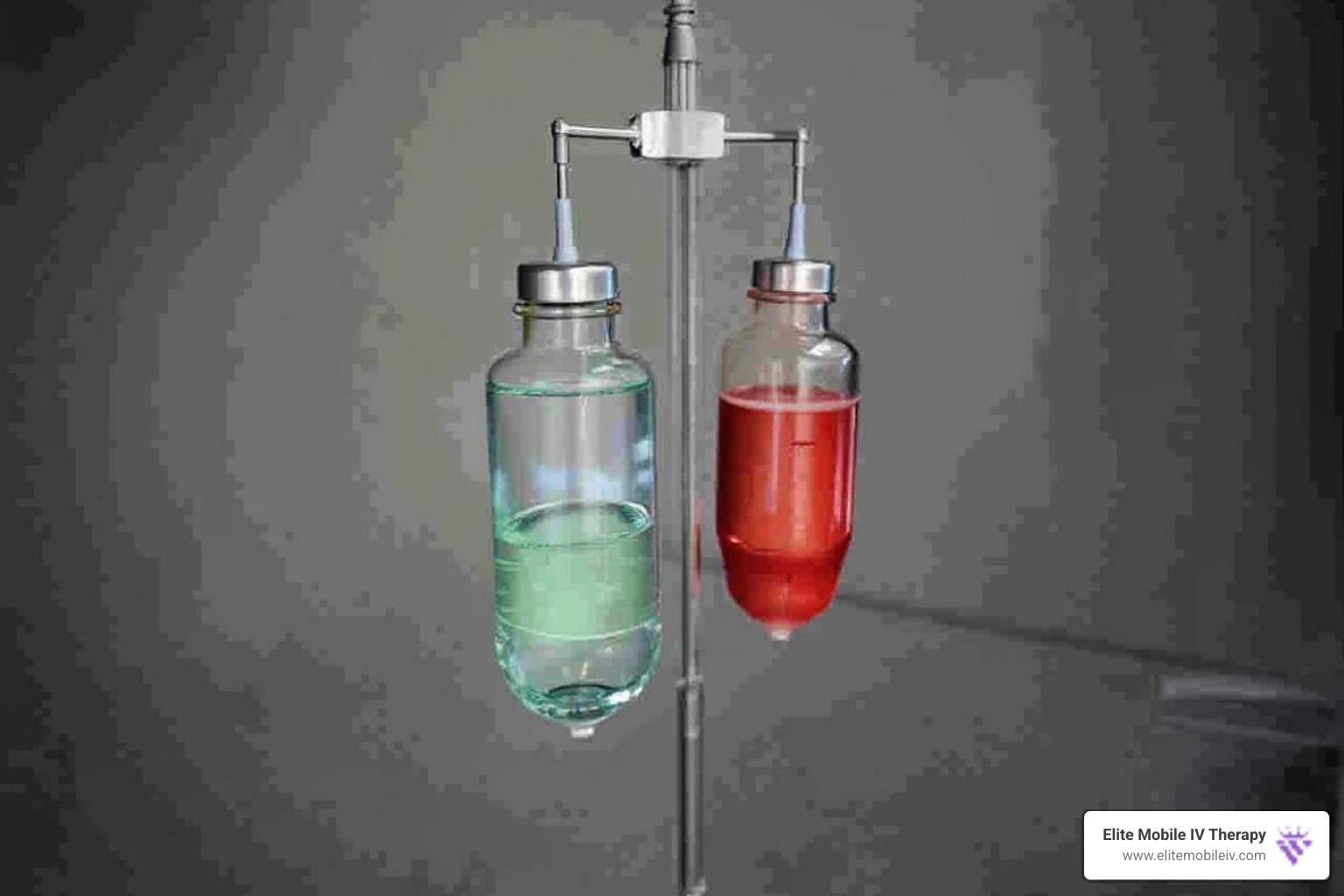
Navigating the Risks of IV Fluids for Infection
IV therapy must be custom: too little fluid worsens shock, but too much causes fluid overload, swelling, or even pulmonary edema that strains the heart and lungs. Inappropriate volumes or fluid types can also shift electrolytes and impair kidney function. Historic incidents, such as the 1970-71 CDC bacteremia outbreak from contaminated bags, triggered today’s strict sterile manufacturing standards.
Large trials remind clinicians that more is not always better. The FEAST trial in African children and similar work in Zambia showed higher mortality with aggressive boluses when advanced monitoring was unavailable. These data urged caution worldwide.
The "Too Much of a Good Thing" Problem in Sepsis
For years, Early Goal-Directed Therapy encouraged large, rapid infusions (e.g., 30 mL/kg). Newer studies, including the CLASSIC trial, indicate that giving more than about 6 L within 24 h can increase deaths. The result: a shift toward personalized, conservative strategies guided by the patient’s real-time response instead of rigid volumes.
How Treatment Protocols Are Changing
Modern fluid management often follows four phases:
- Resuscitation – initial bolus to reverse shock.
- Optimization – small, targeted doses guided by dynamic tests (passive leg raise, stroke-volume variation).
- Stabilization – maintain balance with minimum fluid.
- De-resuscitation – actively remove excess with diuretics or dialysis.
Balanced crystalloids such as Lactated Ringer’s are now preferred over high-chloride normal saline when large volumes are required, lowering the risk of kidney injury and metabolic acidosis.
| Feature | Liberal (Traditional) | Personalized (Modern) |
|---|---|---|
| Initial volume | Large bolus (≈30 mL/kg) | Small bolus only if responsive |
| Fluid type | Normal saline | Balanced crystalloids |
| Assessment | Static vitals | Dynamic tests |
| Goal | Fixed pressure targets | Perfusion without overload |
| De-resuscitation | Rarely addressed | Integral to care |
In short, IV fluids remain lifesaving, but smarter dosing is now the rule.
Personalizing Treatment and the Future of IV Therapy
The journey of IV fluids for infection from a simple rehydration tool to a nuanced, personalized medical intervention is truly fascinating. The emphasis is increasingly on tailoring treatment to the unique needs of each patient, leveraging advanced monitoring and ongoing research to optimize outcomes.
What Factors Determine the Type and Amount of IV Fluids?
Gone are the days of a "one-size-fits-all" approach to IV fluid administration. At Elite Mobile IV Therapy, our medical professionals carefully assess each client as a unique individual, considering a range of factors to determine the most appropriate type and amount of IV fluids for infection support.
Think of it like a custom-custom suit - what works perfectly for one person might be completely wrong for another. The patient's specific infection plays a huge role in our decision-making. A viral gastroenteritis causing dehydration requires a very different approach than a severe bacterial infection that might be progressing toward sepsis.
The severity of illness is equally important. Someone with mild dehydration from a stomach bug will have vastly different fluid requirements than someone experiencing more serious complications. We also carefully consider age and weight- children and elderly patients are more susceptible to fluid imbalances and require especially careful dosing, while body weight helps us calculate appropriate initial fluid volumes.
Pre-existing conditions can dramatically impact how a patient's body handles fluids. Heart failure, kidney disease, or liver problems can severely affect someone's ability to tolerate fluids, making careful monitoring and sometimes fluid restriction absolutely crucial for safety.
We closely monitor vital signs including blood pressure, heart rate, and respiratory rate, which provide immediate clues about hydration status and how well the circulatory system is functioning. Urine output is another critical indicator - it tells us how well the kidneys are being perfused and gives us insight into overall hydration status. When urine output is low, it can signal dehydration or kidney strain.
Lab results provide a wealth of detailed information that guides our treatment decisions. We look at electrolyte levels to identify imbalances in sodium, potassium, and chloride. Kidney function tests like creatinine and BUN help us assess kidney health, while hemoglobin and hematocrit levels show us blood concentration.
One particularly important marker is lactic acid levels. Liftd lactic acid can indicate poor tissue perfusion and is a key marker in sepsis. Measuring lactic acid helps guide fluid resuscitation and assess how effective our treatment is, as highlighted in research on its role in critical care management.
By considering all these factors together, we develop a personalized IV therapy plan that's safe, effective, and optimized for each person's unique recovery needs.
The Future of IV Fluids for Infection Treatment
The field of IV fluid therapy is incredibly dynamic, with continuous research aimed at refining practices and improving patient outcomes. It's exciting to see how the science is evolving, and we're committed to staying at the forefront of these developments.
Ongoing clinical trials are constantly exploring different approaches to fluid therapy. The ARISE FLUIDS trial (NCT04569942) is currently exploring different fluid resuscitation strategies in patients with sepsis, while the CLOVERS trial (NCT03434028) compared restrictive versus liberal fluid strategies in patients with septic shock, adding valuable evidence to guide future practice.
Researchers are also focusing on comparing fluid types more precisely. While balanced solutions are gaining favor over traditional saline, ongoing studies continue to clarify their exact benefits and best uses. Research on saline versus a balanced solution continues to compare these options in various clinical scenarios, helping us understand when each type works best.
There's also growing interest in optimizing administration rates. Some fascinating studies are exploring whether slower fluid administration, even during initial treatment, might be beneficial for certain patients to avoid rapid fluid shifts and potential overload. Studies on slower fluid administration are examining this approach, which could revolutionize how we think about fluid timing.
Advanced hemodynamic monitoring represents another exciting frontier. The development of non-invasive or minimally invasive tools to continuously monitor a patient's fluid responsiveness and cardiac output will become more widespread. This technology will allow for real-time, precise adjustments to fluid therapy, moving us toward truly individualized care.
As medical science advances, we at Elite Mobile IV Therapy remain committed to staying at the forefront of best practices. We continuously update our protocols based on the latest research, ensuring our clients receive the most effective and safe IV fluids for infection support available. The future of IV therapy is bright, and we're excited to bring these advances directly to your home, office, or hotel room.
Frequently Asked Questions about IV Fluids for Infections
We often hear from our wonderful clients who have questions about IV fluids for infection. It's totally understandable to be curious about how these powerful treatments work, especially when you're not feeling your best. So, let's dive into some of the most common questions we get, and we'll share our expert answers in a way that's easy to understand.
How long does it take for IV fluids to work for an infection?
This is a great question, and the answer has two parts! When you receive IV fluids for infection, especially if you're feeling really dehydrated from something like a stomach bug, you'll likely notice the immediate benefits pretty quickly. We're talking about feeling less dizzy, your thirst easing, and that nagging fatigue starting to lift. Many people feel a significant improvement in these dehydration symptoms within just minutes to an hour of starting the infusion. In fact, for severe dehydration, the CDC even suggests re-checking your hydration status every 15 to 30 minutes! It's like giving your body a fast-track to feeling refreshed.
However, while IV fluids are fantastic at supporting your body and making you feel better, they aren't a direct cure for the infection itself. Your immune system still needs to do its job fighting off that pesky virus or bacteria. If you have a bacterial infection, antibiotics will need time to work their magic too. So, while you'll get rapid relief from dehydration and electrolyte imbalances, the full recovery from the infection will depend on its specific type and how severe it is. Think of the fluids as your body's best cheerleader, giving it the strength to win the fight!
Can I get IV fluids for an infection at home?
Absolutely! In many situations, you can indeed receive IV fluids for infection support right in the comfort of your own home. The world of home healthcare has really expanded, and mobile IV therapy services, like ours at Elite Mobile IV, are making it super convenient and accessible.
Now, a quick but important distinction: if you're dealing with something very severe, like life-threatening dehydration or a serious condition like sepsis, a hospital setting is definitely the place to be. They have the constant monitoring and advanced care needed for such critical situations. Our services are designed to be supportive and complementary to traditional medical care, not a replacement for emergency intervention.
But for those mild to moderate cases—say, you're battling a persistent stomach flu that's causing nausea, vomiting, or just leaving you completely drained, or a nasty cold that's zapping your energy—mobile IV therapy can be a real game-changer. It means you can get rapid rehydration and symptom relief without having to leave your couch, office, or hotel room. Imagine feeling better without the hassle of a clinic visit!
Before we administer any IV therapy, our medical professionals at Elite Mobile IV Therapy always conduct a thorough assessment. This ensures that getting IV fluids at home is completely safe and appropriate for your unique situation. We're proud to bring this hospital-grade care directly to you, serving clients in fantastic areas like Greenville SC, Asheville NC, Charlotte NC, Raleigh NC, Knoxville TN, and Nashville TN. If you're curious to learn more about home IV therapy options in general, you can check out this resource: Information on home IV therapy options.
When should I see a doctor for an infection?
While IV fluids for infection can be a wonderful supportive tool, it's incredibly important to know when an infection needs the attention of a doctor or even emergency services. Your health is paramount, so here are some key signs and symptoms that mean it's time to seek professional medical care:
- Signs of severe dehydration: This is more than just feeling thirsty. Look for things like extreme thirst, feeling dizzy or lightheaded, confusion, very little or no urination, or noticeably sunken eyes.
- High or persistent fever: A fever that's very high (think above 103°F or 39.4°C) or one that just won't quit, lasting for more than a few days, especially if other severe symptoms are present.
- Symptoms that just won't go away: If those typical infection symptoms – like vomiting, diarrhea, a cough, or general fatigue – linger for an unusually long time (say, over a week), it's definitely time for a doctor's visit.
- Trouble breathing: If you're experiencing difficulty breathing or shortness of breath, this is a serious symptom that needs immediate medical evaluation.
- Severe pain: Any unexplained, intense pain in your body should be checked out.
- Suspected sepsis: This is a medical emergency. Be on the lookout for a combination of symptoms like fever or chills, feeling confused, a rapid heart rate, very fast breathing, extreme pain or discomfort that feels "out of proportion," and clammy skin.
- Worsening symptoms: If you feel like your symptoms are getting worse instead of better, even after trying home care.
- If you have other health conditions: If you have a weakened immune system, chronic illnesses (like diabetes, heart disease, or kidney disease), or if you're very young or elderly, you should seek medical attention much sooner for infections.
The National Institute of Diabetes and Digestive and Kidney Diseases (NIDDK) offers excellent guidance on when to seek medical care, particularly for conditions like viral gastroenteritis, emphasizing the importance of recognizing severe symptoms. You can read more about it here: Guidance on when to seek medical care. When in doubt, it's always, always best to play it safe and consult a healthcare professional. Your well-being is worth it!
Conclusion
IV fluids do not kill germs, but they create the conditions your immune system needs to win the fight: balanced hydration, steady blood pressure, and restored electrolytes. From critical sepsis care to a stubborn stomach bug, timely IV support can shorten misery and speed recovery.
Elite Mobile IV Therapy brings hospital-grade hydration to your doorstep the very same day. Our licensed clinicians serve Greenville, Asheville, Charlotte, Raleigh, Knoxville, and Nashville with personalized formulas and extended hours.
Ready to bounce back? Find our in-home illness-recovery options: Learn more about our in-home IV therapy services for illness recovery.




